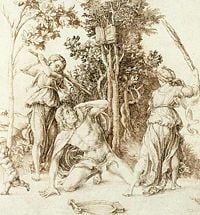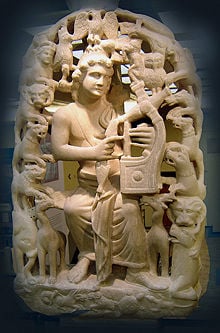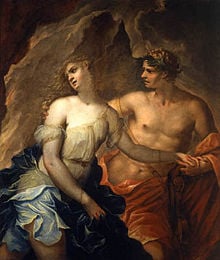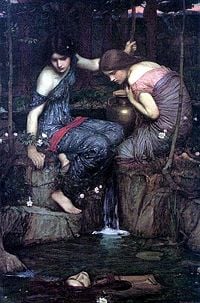Orpheus
Orpheus (Greek: Ορφεύς; pronunciation: ohr'-fee-uhs)[1] is a figure from Greek mythology called by Pindar "the minstrel father of songs."[2] His name does not occur in Homer or Hesiod, though he was known by the time of Ibycus (c. 530 B.C.E.).[3]
In the poetic and mythic corpora, Orpheus was the heroic (i.e. semi-divine) son of the Thracian king Oeagrus and the muse Calliope, a provenance that guaranteed him certain superhuman skills and abilities.[4] In particular, he was described as the most exalted musician in antiquity, whose heavenly voice could charm wild beasts, coax the trees and rocks into dancing, and even divert the course of rivers.[5] In addition, Apollodorus (and other classical mythographers) describe Orpheus as the sailing companion of Jason and the Argonauts.[6]
Some of the other traits associated with Orpheus (and with the mystery religion bearing his name) suggest that he was an augur and seer; practised magical arts, especially astrology; founded or rendered accessible many important cults, such as those of Apollo and the Thracian god Dionysus; instituted mystic rites both public and private; and prescribed initiatory and purificatory rituals.[7]
Mythology
Origins and early life
The mythic accounts describing the provenance of Orpheus lack a consensus on the parents of the musical hero. While most suggest that his father was Oeagrus (the king of Thrace) and that his mother was the muse Calliope,[8] many alternate lineages also exist. Most significantly, he is occasionally seen as the son of Apollo and either Calliope or a mortal woman—an understandable attribution, given their mutual prowesses in the performing arts.[9]
While living with his mother and his eight beautiful aunts on Parnassus, he met the god Apollo who was courting the laughing muse Thalia. Apollo became fond of Orpheus and gave him a little golden lyre, and taught him to play it. Orpheus's mother taught him to make verses for singing.
Argonautic expedition
Orpheus joined the expedition of the Argonauts. The centaur Chiron had warned the Argonaut leader Jason that only with the aid of Orpheus would they be able to navigate past the Sirens unscathed. The Sirens lived on three small, rocky islands called Sirenum scopuli and played irresistibly beautiful songs that enticed sailors and their ships to the islands' craggy shoals, where the ships would be wrecked and the sailors killed by the sirens. However, when Orpheus heard the sirens, he drew his lyre and played music more beautiful than theirs, drowning out their alluring but deadly song.
Death of Eurydice
The most famous story in which Orpheus figures is that of his wife Eurydice (also known as Agriope). While fleeing from Aristaeus (son of Apollo), Eurydice ran into a nest of snakes which bit her fatally on her legs. Distraught, Orpheus played such sad songs and sang so mournfully that all the nymphs and gods wept. On their advice, Orpheus travelled to the underworld and by his music softened the hearts of Hades and Persephone (he was the only person ever to do so), who agreed to allow Eurydice to return with him to earth on one condition: he should walk in front of her and not look back until he had reached the upper world. In his anxiety he broke his promise, and Eurydice vanished again from his sight.
The story in this form belongs to the time of Virgil, who first introduces the name of Aristaeus. Other ancient writers, however, speak of Orpheus' visit to the underworld; according to Plato, the infernal gods only "presented an apparition" of Eurydice to him. Ovid says that Eurydice's death was not caused by fleeing from Aristaeus but by dancing with naiads on her wedding day.
The story of Eurydice may actually be a late addition to the Orpheus myths. In particular, the name Eurudike ("she whose justice extends widely") recalls cult-titles attached to Persephone. The myth may have been mistakenly derived from another Orpheus legend in which he travels to Tartarus and charms the goddess Hecate.
The descent to the Underworld of Orpheus is paralleled in other versions of a worldwide theme: the Japanese myth of Izanagi and Izanami, the Akkadian/Sumerian myth of Inanna's Descent to the Underworld, and Mayan myth of Ix Chel and Itzamna. The mytheme of not looking back is reflected in the story of Lot's wife when escaping from Sodom. More directly, the story of Orpheus is similar to the ancient Greek tales of Persephone captured by Hades and similar stories of Adonis captive in the underworld. However, the developed form of the Orpheus myth was entwined with the Orphic mystery cults and, later in Rome, with the development of Mithraism and the cult of Sol Invictus; the predecessors of Orpheus.
Death

According to some versions of the story (notably Ovid's), Orpheus forswore the love of women after the death of Eurydice and took only youths as his lovers; he was reputed to be the one who introduced pederasty to the Thracians, teaching them to "love the young in the flower of their youth".
According to a Late Antique summary of Aeschylus's lost play Bassarids, Orpheus at the end of his life disdained the worship of all gods save the sun, whom he called Apollo. One early morning he went to the Oracle of Dionysus (there are ongoing discussions whether this is Perperikon or Mount Pangaion) to salute his god at dawn, but was torn to death by Thracian Maenads for not honoring his previous patron, Dionysus. Here his death is analogous with the death of Dionysus, to whom therefore he functioned as both priest and avatar. Ovid (Metamorphoses XI) also recounts that the Thracian Maenads, Dionysus' followers, angry for having been spurned by Orpheus in favor of "tender boys," first threw sticks and stones at him as he played, but his music was so beautiful even the rocks and branches refused to hit him. Enraged, the Maenads tore him to pieces during the frenzy of their Bacchic orgies. Later, the story would sometimes be seen from a Christian moralist angle: in Albrecht Dürer's drawing (illustration, left) the ribbon high in the tree is lettered Orfeus der erst puseran ("Orpheus, the first sodomite").
His head and lyre, still singing mournful songs, floated down the swift Hebrus to the Mediterranean shore. There, the winds and waves carried them on to the Lesbos shore, where the inhabitants buried his head and a shrine was built in his honour near Antissa; there his oracle prophesied, until it was silenced by Apollo (Life of Apollonius of Tyana, book v.14). The lyre was carried to heaven by the Muses, and was placed among the stars. The Muses also gathered up the fragments of his body and buried them at Leibethra below Mount Olympus, where the nightingales sang over his grave. His soul returned to the underworld, where he was re-united at last with his beloved Eurydice.
Bulgarian archeologists have discovered, near Tatul, an ancient Thracian tomb that some have described as "the tomb of Orpheus".[10]
The Orphic Mysteries

A number of Greek religious poems in hexameter were attributed to Orpheus, as they were to similar miracle-working figures, like Bakis, Musaeus, Abaris, Aristeas, Epimenides, and the Sybil. Of this vast literature, only two examples survive whole: a set of hymns composed at some point in the second or third century AD, and an Orphic Argonautica composed somewhere between the fourth and sixth centuries AD. Earlier Orphic literature, which may date back as far as the sixth century B.C.E., survives only in papyrus fragments or in quotations.
In addition to serving as a storehouse of mythological data along the lines of Hesiod's Theogony, Orphic poetry was recited in mystery-rites and purification rituals. Plato in particular tells of a class of vagrant beggar-priests who would go about offering purifications to the rich, a clatter of books by Orpheus and Musaeus in tow (Republic 364c-d). Those who were especially devoted to these ritual and poems often practiced vegetarianism, abstention from sex, and refrained from eating eggs and beans — which came to be known as the Orphikos bios, or "Orphic way of life".[11]
The Derveni papyrus, found in Derveni, Macedonia, in 1962, contains a philosophical treatise that is an allegorical commentary on an Orphic poem in hexameters, a theogony concerning the birth of the gods, produced in the circle of the philosopher Anaxagoras, written in the second half of the fifth century B.C.E. Fragments of the poem are quoted making it "the most important new piece of evidence about Greek philosophy and religion to come to light since the Renaissance"[12]. The papyrus dates to around 340 B.C.E., during the reign of Philip II of Macedon, making it Europe's oldest surviving manuscript.
The historian William Mitford wrote in 1784 that the very earliest form of a higher and cohesive ancient Greek religion was manifest in the Orphic poems.[13]
W.K.C. Guthrie wrote that Orpheus was the founder of mystery religions and the first to reveal to men the meanings of the initiation rites.[14]
Mystery schools
Besides the better known "mystery schools" of Pythagoras and Plato, there were well established "Orphic" mystery schools that purported to convey esoteric and metaphysical knowledge. Due to societal persecution and suppression, these were secret schools for the study of the mysteries of the "Inner Nature" of man and of surrounding nature. By understanding these mysteries, the student attempted to perceive his intimate relationship with Divinity, and strove through self-discipline and devotion to become at one with his "Inner God". [15]
Post-classical Orpheus
The Orpheus legend has remained a popular subject for writers, artists, musicians and filmmakers, inspiring poetry, novels, musical compositions, visual art, animation, and films.[16]
Notes
- ↑ The mythological name "Orpheus" is commonly pronounced "ohr'-fee-uhs" in English, although some names have a different pronunciation in ancient Greek; see "Encyclopedia Mythica: Pronunciation guide" webpage:Pantheon-pron.
- ↑ Pindar, Pythian Odes IV: For Arkesilas of Kyrene (line 177). Translated by Ernest Myers, 1904. Accessible at Project Gutenberg. Retrieved July 23, 2007.
- ↑ While Ibycus's reference is the first found in literature (Robbins (1982)), a sculptural depiction of the demigod as a member of the Argonauts, found on "the metopes of the Sikuonian monopteros at Delphi," could predate it. Gantz, 721.
- ↑ Powell, 303.
- ↑ For a list of mythic references to these magical abilities, see Gantz, 721.
- ↑ Apollodorus, 1.9.16; Apollonios, Argonotica, 4.891-911.
- ↑ Grote, p. 21.
- ↑ This opinion is held by Bakchylides, Plato, Apollonios, Diodorus, and others (Gantz, 725).
- ↑ Pindar, Asklepiades, et al (Gantz, 725).
- ↑ http://www.ancient-bulgaria.com/2006/08/31/tatul-the-possible-tomb-of-orpheus/
- ↑ Moore, p. 56 says that "the use of eggs and beans was forbidden, for these articles were associated with the worship of the dead".
- ↑ Richard Janko, Bryn Mawr Classical Review, (2006) of K. Tsantsanoglou, G.M. Parássoglou, T. Kouremenos (editors), 2006. The Derveni Papyrus (Florence: Olschki) series "Studi e testi per il "Corpus dei papiri filosofici greci e latini", vol. 13]).
- ↑ Mitford, p.89: "But the very early inhabitants of Greece had a religion far less degenerated from original purity. To this curious and interesting fact, abundant testimonies remain. They occur in those poems, of uncertain origin and uncertain date, but unquestionably of great antiquity, which are called the poems of Orpheus or rather the Orphic poems [particularly in the Hymn to Jupiter, quoted by Aristotle in the seventh chapter of his Treatise on the World: Ζευς πρωτος γενετο, Ζευς υςατος, x. τ. ε]; and they are found scattered among the writings of the philosophers and historians."
- ↑ Guthrie, p.17. "As founder of mystery-religions, Orpheus was first to reveal to men the meaning of the rites of initiation (teletai). We read of this in both Plato and Aristophanes (Aristophanes, Frogs, 1032; Plato, Republic, 364e, a passage which suggests that literary authority was made to take the responsibility for the rites". Guthrie goes on to write about "... charms and incantations of Orpheus which we may also read of as early as the fifth century B.C.E. Our authority is Euripides, Alcestis (referencing the Charm of the Thracian Tablets) and in Cyclops, the spell of Orpheus".
- ↑ Knoche, Grace F. Mystery Schools Through the Ages.
- ↑ As Wikipedia is openly editable, it is often the best place to find up-to-date information on pop culture. As a result, please consult their article on Orpheus for a summary of these artistic endeavors.
ReferencesISBN links support NWE through referral fees
- Apollodorus. Gods & Heroes of the Greeks. Translated and with an Introduction and Notes by Michael Simpson. Amherst, MA: University of Massachusetts Press, 1977. ISBN 0-87023-205-3.
- Bernabé, Albertus (ed.). Orphicorum et Orphicis similium testimonia et fragmenta. Poetae Epici Graeci. Pars II. Fasc. 1. Bibliotheca Teubneriana, München/Leipzig: K.G. Saur, 2004. ISBN 3-598-71707-5. review of this book
- Gantz, Timothy. Early Greek Myth: A Guide to Literary and Artistic Sources. Baltimore: Johns Hopkins University Press, 1993. ISBN 080184410X.
- Guthrie, W. K. C. Orpheus and Greek Religion: a Study of the Orphic Movement. London: Methuen, 1952.
- Moore, Clifford H. Religious Thought of the Greeks. Kessinger Publishing, 2003. ISBN 0766151301.
- The Mystical Hymns of Orpheus. Translated by Thomas Taylor. 1896. Accessible online at sacred-texts.com.
- Nilsson, Martin P. Greek Popular Religion. New York: Columbia University Press, 1940. Also accessible online at sacred-texts.com.
- Powell, Barry B. Classical Myth (Second Edition). Upper Saddle River, NJ: Prentice Hall, 1998. ISBN 0-13-716714-8.
- Price, Simon. Religions of the Ancient Greeks. Cambridge: Cambridge University Press, 1999. ISBN 0-521-38867-8.
- Robbins, Emmet. "Famous Orpheus" in John Warden's Orpheus: the metamorphoses of a myth. Toronto: University of Toronto Press, 1982. ISBN 0802055184.
- Rohde, Erwin. "The Orphics" in Psyche: The Cult of Souls and Belief in Immortality among the Greeks. Chicago: Ares, 1987. ISBN 0890054770.
- Rose, H. J. A Handbook of Greek Mythology. New York: E. P. Dutton & Co., 1959. ISBN 0-525-47041-7.
- Ruck, Carl A.P. and Staples, Daniel. The World of Classical Myth. Durham, NC: Carolina Academic Press, 1994. ISBN 0-89089-575-9.
- Smith, William. "Orpheus." Dictionary of Greek and Roman Biography and Mythology, 1870. Accessible online at ancientlibrary.com.
- West, Martin Litchfield. The Orphic Poems, Oxford: Clarendon Press; New York: Oxford University Press, 1983. ISBN 0198148542.
External links
- Greek Mythology Link, Orpheus - retrieved July 23, 2007.
- Online Text: The Orphic Hymns translated by Thomas Taylor - retrieved July 23, 2007.
- The Story of Orpheus - retrieved July 23, 2007.
- Orphica in English and Greek, Select Resources - retrieved July 23, 2007.
Credits
New World Encyclopedia writers and editors rewrote and completed the Wikipedia article in accordance with New World Encyclopedia standards. This article abides by terms of the Creative Commons CC-by-sa 3.0 License (CC-by-sa), which may be used and disseminated with proper attribution. Credit is due under the terms of this license that can reference both the New World Encyclopedia contributors and the selfless volunteer contributors of the Wikimedia Foundation. To cite this article click here for a list of acceptable citing formats.The history of earlier contributions by wikipedians is accessible to researchers here:
The history of this article since it was imported to New World Encyclopedia:
Note: Some restrictions may apply to use of individual images which are separately licensed.



